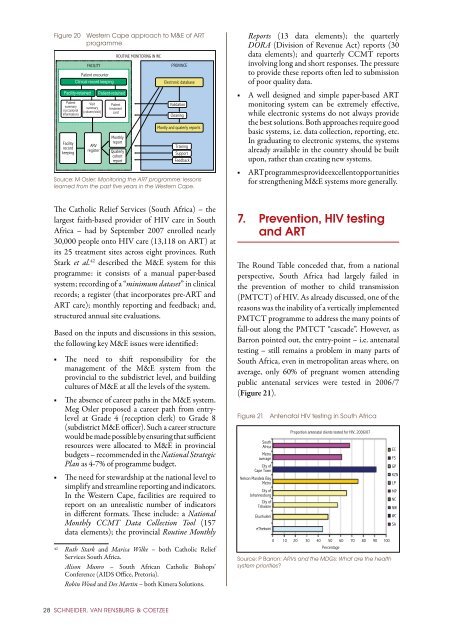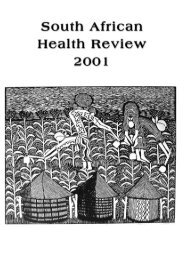Round Table Report - UCT Main - University of Cape Town
Round Table Report - UCT Main - University of Cape Town
Round Table Report - UCT Main - University of Cape Town
Create successful ePaper yourself
Turn your PDF publications into a flip-book with our unique Google optimized e-Paper software.
Figure 20 Western <strong>Cape</strong> approach to M&E <strong>of</strong> ART<br />
programme<br />
FACILITY<br />
Clinical record keeping<br />
Facility-retained<br />
Patient<br />
summary<br />
(occasional<br />
information)<br />
Facility<br />
record<br />
keeping<br />
Patient encounter<br />
Visit<br />
summary<br />
(column/visit)<br />
ARV<br />
register<br />
Patient-retained<br />
Patient<br />
treatment<br />
card<br />
ROUTINE MONITORING IN WC<br />
Monthly<br />
report<br />
Quaterly<br />
cohort<br />
report<br />
PROVINCE<br />
Electronic database<br />
Validation<br />
Cleaning<br />
Montly and quaterly reports<br />
Training<br />
Support<br />
Feedback<br />
Source: M Osler: Monitoring the ART programme: lessons<br />
learned from the past five years in the Western <strong>Cape</strong>.<br />
■■<br />
■■<br />
<strong>Report</strong>s (13 data elements); the quarterly<br />
DORA (Division <strong>of</strong> Revenue Act) reports (30<br />
data elements); and quarterly CCMT reports<br />
involving long and short responses. The pressure<br />
to provide these reports <strong>of</strong>ten led to submission<br />
<strong>of</strong> poor quality data.<br />
A well designed and simple paper-based ART<br />
monitoring system can be extremely effective,<br />
while electronic systems do not always provide<br />
the best solutions. Both approaches require good<br />
basic systems, i.e. data collection, reporting, etc.<br />
In graduating to electronic systems, the systems<br />
already available in the country should be built<br />
upon, rather than creating new systems.<br />
ART programmes provide excellent opportunities<br />
for strengthening M&E systems more generally.<br />
The Catholic Relief Services (South Africa) – the<br />
largest faith-based provider <strong>of</strong> HIV care in South<br />
Africa – had by September 2007 enrolled nearly<br />
30,000 people onto HIV care (13,118 on ART) at<br />
its 25 treatment sites across eight provinces. Ruth<br />
Stark et al. 42 described the M&E system for this<br />
programme: it consists <strong>of</strong> a manual paper-based<br />
system; recording <strong>of</strong> a “minimum dataset” in clinical<br />
records; a register (that incorporates pre-ART and<br />
ART care); monthly reporting and feedback; and,<br />
structured annual site evaluations.<br />
Based on the inputs and discussions in this session,<br />
the following key M&E issues were identified:<br />
■■ The need to shift responsibility for the<br />
management <strong>of</strong> the M&E system from the<br />
provincial to the subdistrict level, and building<br />
cultures <strong>of</strong> M&E at all the levels <strong>of</strong> the system.<br />
■■ The absence <strong>of</strong> career paths in the M&E system.<br />
Meg Osler proposed a career path from entrylevel<br />
at Grade 4 (reception clerk) to Grade 8<br />
(subdistrict M&E <strong>of</strong>ficer). Such a career structure<br />
would be made possible by ensuring that sufficient<br />
resources were allocated to M&E in provincial<br />
budgets – recommended in the National Strategic<br />
Plan as 4-7% <strong>of</strong> programme budget.<br />
■■ The need for stewardship at the national level to<br />
simplify and streamline reporting and indicators.<br />
In the Western <strong>Cape</strong>, facilities are required to<br />
report on an unrealistic number <strong>of</strong> indicators<br />
in different formats. These include: a National<br />
Monthly CCMT Data Collection Tool (157<br />
data elements); the provincial Routine Monthly<br />
42 Ruth Stark and Marisa Wilke – both Catholic Relief<br />
Services South Africa.<br />
Alison Munro – South African Catholic Bishops’<br />
Conference (AIDS Office, Pretoria).<br />
Robin Wood and Des Martin – both Kimera Solutions.<br />
7. Prevention, HIV testing<br />
and ART<br />
The <strong>Round</strong> <strong>Table</strong> conceded that, from a national<br />
perspective, South Africa had largely failed in<br />
the prevention <strong>of</strong> mother to child transmission<br />
(PMTCT) <strong>of</strong> HIV. As already discussed, one <strong>of</strong> the<br />
reasons was the inability <strong>of</strong> a vertically implemented<br />
PMTCT programme to address the many points <strong>of</strong><br />
fall-out along the PMTCT “cascade”. However, as<br />
Barron pointed out, the entry-point – i.e. antenatal<br />
testing – still remains a problem in many parts <strong>of</strong><br />
South Africa, even in metropolitan areas where, on<br />
average, only 60% <strong>of</strong> pregnant women attending<br />
public antenatal services were tested in 2006/7<br />
(Figure 21).<br />
Figure 21 Antenatal HIV testing in South Africa<br />
South<br />
Africa<br />
Metro<br />
average<br />
City <strong>of</strong><br />
<strong>Cape</strong> <strong>Town</strong><br />
Nelson Mandela Bay<br />
Metro<br />
City <strong>of</strong><br />
Johannesburg<br />
City <strong>of</strong><br />
Tshwane<br />
Ekurhuleni<br />
eThekwini<br />
Proportion antenatal clients tested for HIV, 2006/07<br />
0 10 20 30 40 50 60 70 80 90 100<br />
Percentage<br />
Source: P Barron: ARVs and the MDGs: What are the health<br />
system priorities?<br />
EC<br />
FS<br />
GP<br />
KZN<br />
LP<br />
MP<br />
NC<br />
NW<br />
WC<br />
SA<br />
28 Schneider, Van Rensburg & Coetzee

















